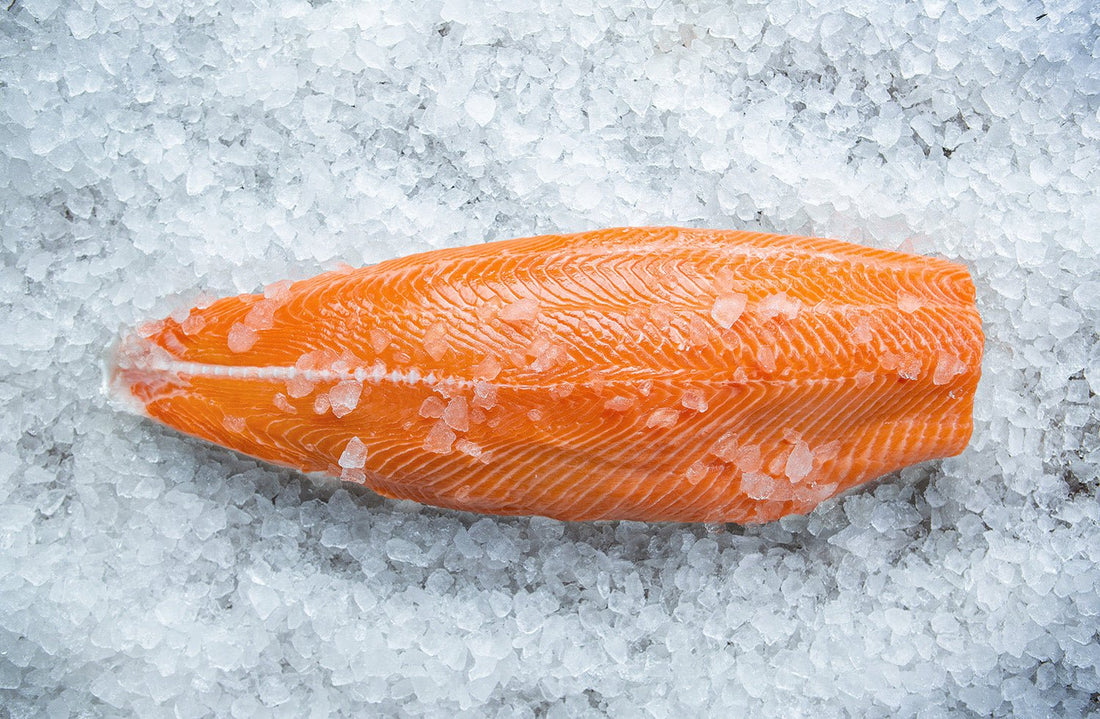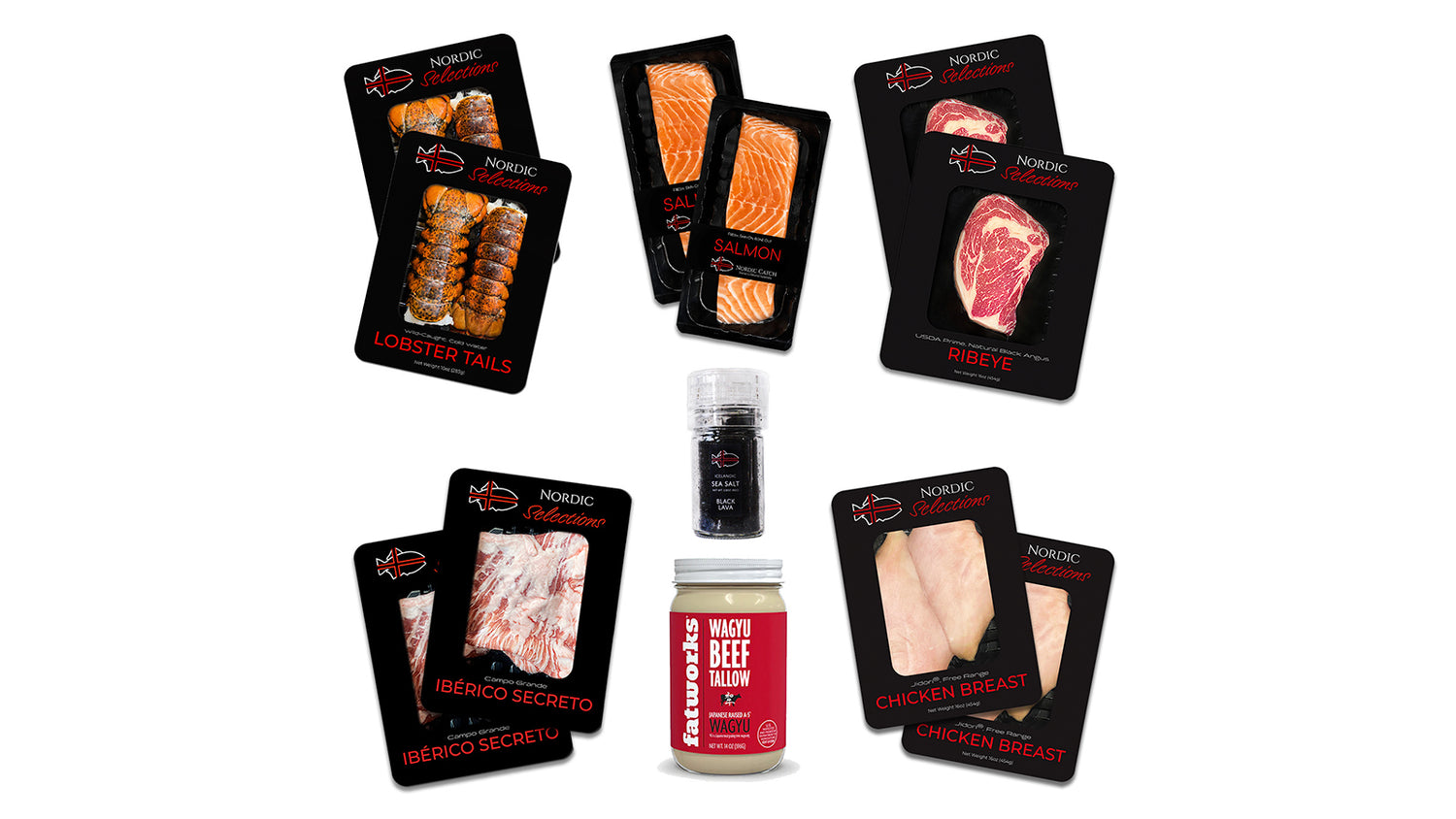
Is Farm-Raised Salmon Bad for You?
Farm-raised salmon makes up about 70% of the global supply. However, plenty of misconceptions exist about its health benefits and quality. While it plays a crucial role in meeting the growing demand for seafood, you might wonder: Is farm-raised salmon bad for you?
As experts in seafood and bulk seafood delivery, we'll dispel the myths, explain the facts, and compare farm-raised salmon to wild salmon so you can make the best choice for your next meal.
What Is Farm-Raised Salmon?
Farm-raised salmon is produced through aquaculture, where farmers breed and raise the fish in controlled environments. This farming practice supports the high demand for salmon, as wild stocks often can't meet consumption needs. Farming typically lasts one to three years and involves several stages, from juvenile to harvesting.
Chefs often use farm-raised salmon for dishes like salmon sashimi or smoked salmon, as it's available year-round and consistently high-quality.
3 Phases of Salmon Farming
Salmon farming is a multi-phase process:
- Juvenile phase: The farmers initially raise salmon in freshwater tanks for 6-12 months.
- Growth phase: They move the fish to underwater cages or ocean pens.
- Harvesting: They harvest the salmon when they reach market size.
Is Farm-Raised Salmon Safe to Eat?
Discrepancies in recommended safety standards between the United States Food & Drug Administration and the Environmental Protection Agency have led to confusion about the safety of farm-raised salmon. However, farm-raised salmon is generally safe to eat when sourced responsibly. Government agencies like the FDA regulate contaminants in farmed fish, setting limits on PCBs (polychlorinated biphenyls) and other toxins.
For example, comparing Atlantic and Pacific salmon, Atlantic salmon benefits from careful monitoring in controlled environments, reducing contamination risks. Wild-caught Pacific salmon depends on natural habitat conditions and responsible fishing practices. With proper sourcing and regulations, both are safe and nutritious options.
Many people choose farm-raised salmon because it is affordable and accessible. While the potential risks of contaminants exist, they are outweighed by the nutritional benefits of omega-3s, high-quality protein, and essential vitamins. To create delicious and healthy meals, you can incorporate farm-raised salmon into many of the best ways to cook salmon, such as baking, grilling, or poaching it.
Nutritional Value of Farm-Raised Salmon
Farm-raised salmon is a nutrient-packed fish with many health benefits. It is one of the healthiest seafood options and one of the most popular seafood in the U.S. A 3.5-ounce serving provides around 22 grams of high-quality protein and 2.3 grams of omega-3 fatty acids.
Omega-3s, particularly EPA and DHA, benefit your heart and brain health in the following ways:
- Reduce inflammation
- Lower blood pressure
- Help prevent irregular heartbeats
- Support cognitive function
- Improve memory
- It may reduce the risk of age-related mental decline.
Farm-raised salmon is also rich in B vitamins, including B12, B6, and niacin. It provides over 100% of your daily value of vitamin B12 in a single serving. Additionally, the fish contains essential minerals like selenium and potassium, which support multiple bodily functions.
How to Select High-Quality Farm-Raised Salmon
When you shop for farm-raised salmon, look for certifications that indicate responsible farming practices. Labels like organic, non-GMO, and antibiotic-free can help you select higher-quality salmon. Additionally, certifications from responsible farming organizations, like the Aquaculture Stewardship Council (ASC) or Best Aquaculture Practices (BAP), ensure that farmers produce salmon sustainably.
How to Reduce Contaminants in Farm-Raised Salmon
Cooking methods can help reduce the levels of contaminants in farm-raised salmon. Since contaminants are stored in the fish's fat, trim as much visible fat and skin as possible. Grill or broil the fish to let excess fat drip away and reduce contaminants. Or poach or steam the fish to preserve its nutrients while removing some contaminants. And remember: Always safely thaw seafood in the refrigerator or under cold running water before cooking it.
Farm-raised Salmon vs. Wild Salmon
When choosing between farm-raised fish and wild-caught fish, it's essential to understand the key differences that impact their nutritional value and environmental footprint. While both types offer significant health benefits, they differ in habitat, diet, and nutritional composition. Here's a look at how the two compare:
Habitat
Wild salmon live in natural ocean environments, migrating long distances and feeding on a varied diet of fish, plankton, and other marine organisms. Farm-raised salmon live in controlled environments like ocean pens or land-based tanks, where their movement is restricted, sometimes affecting their development and nutritional profile.
Diet
Wild salmon consume a diverse range of smaller fish, krill, and plankton, which provide a balanced array of nutrients. Farm-raised salmon eat a controlled diet of fish meal, fish oil, and plant-based proteins, leading to differences in fat content and other nutrients.
Nutritional Composition
Farm-raised salmon tend to contain more omega-3 fatty acids, thanks to the fish oil in their diet, but also have higher omega-6 fatty acids due to plant-based oils in their feed. Wild salmon has a more balanced omega-3 to omega-6 ratio and is sometimes leaner, with less fat overall.
Contaminants
Farm-raised salmon that haven't been sustainably sourced may contain higher levels of PCBs and other contaminants due to their feed, including fish oils and meals from smaller fish that accumulate toxins. These factors increase the likelihood of contaminants in farmed fish. In contrast, wild salmon and responsibly farm-raised salmon generally have lower levels of contaminants, as they live in more natural environments and consume a diverse diet, reducing the accumulation of harmful substances.
Flavor and Texture
Wild salmon has a firmer texture and stronger, more distinct flavor thanks to its active lifestyle and varied diet of smaller fish, plankton, and krill. The constant movement and diverse feeding habits contribute to its robust taste. Farm-raised salmon, on the other hand, tends to be milder and softer due to its controlled diet and space. This can result in a more delicate texture.
Sustainable Salmon Farming Practices
The aquaculture industry is working hard to lessen the environmental impact of salmon farming. They're using more sustainable feed, reducing pesticides and antibiotics, and moving toward closed containment systems. These steps improve the quality of farmed salmon while reducing environmental harm. Certifications like the ASC and BAP help farms follow sustainable and ethical practices.
Nordic Catch only works with sustainable aquaculturists who aim to ensure the safety of marine ecosystems and minimize waste buildup. These ethical aquaculturists avoid crowded farm conditions, which lead to stress, higher disease rates, and concerns about the humane treatment of the fish.
Frequently Asked Questions
Is farm-raised salmon safe to eat?
Farm-raised salmon is generally safe, providing high-quality protein and omega-3 fatty acids if sourced from ethical and sustainable aquaculturists. Salmon farms that lack ethical standards or practice irresponsible methods may contain more contaminants than wild salmon, which you can reduce somewhat through cooking.
How does farm-raised salmon compare nutritionally to wild salmon?
Farm-raised salmon has higher omega-3 and fat content and more omega-6 fatty acids (and sometimes more potential contaminants, depending on the farm's methods). Still, both types are excellent sources of protein, B vitamins, and minerals.
What are the environmental concerns with salmon farming?
Salmon farming can cause pollution, disease transfer to wild fish, and overfishing for feed, though many farms have adopted sustainable practices to address these issues.
How can I choose high-quality farm-raised salmon?
Look for organic, non-GMO, and antibiotic-free certifications, and choose salmon from farms certified by the ASC or BAP for responsible practices.
Are there ways to reduce contaminants when cooking farm-raised salmon?
Yes, removing the skin and fat, grilling or broiling, and poaching or steaming can help reduce contaminants in farm-raised salmon.

